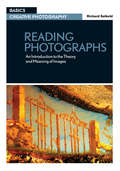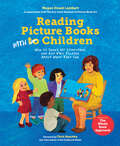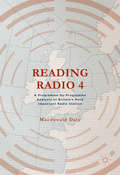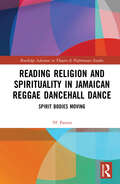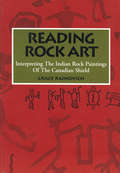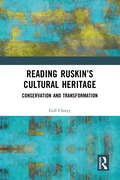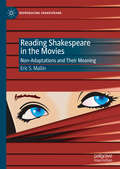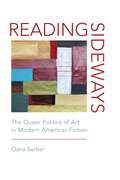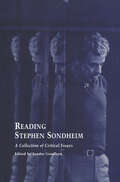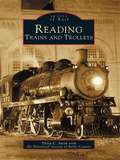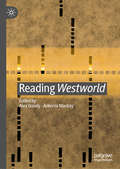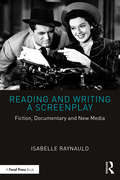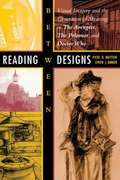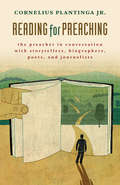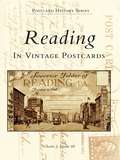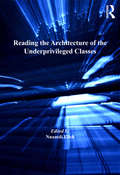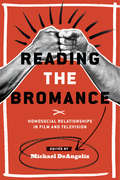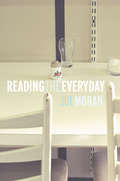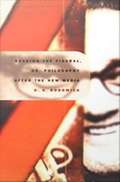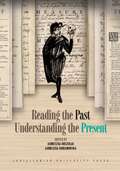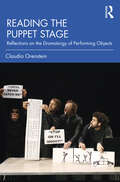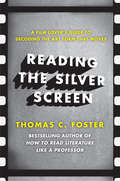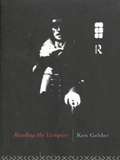- Table View
- List View
Reading Photographs: An Introduction to the Theory and Meaning of Images (Basics Creative Photography)
by Richard SalkeldReading Photographs is a clear and inspiring introduction to theories of representation and visual analysis and how they can be applied to photography. Introducing the development of photography and different approaches to reading images, the book looks at elements such as identity, gaze, psychoanalysis, voyeurism and aesthetics.Striking visual examples are used to illustrate the text and engaging case studies delve deeper into issues raised within each chapter, with brief activity points to allow the reader to apply relevant theories to their own practice.
Reading Picture Books with Children: How to Shake Up Storytime and Get Kids Talking about What They See
by Megan Dowd LambertA new, interactive approach to storytime, The Whole Book Approach was developed in conjunction with the Eric Carle Museum of Picture Book Art and expert author Megan Dowd Lambert's graduate work in children's literature at Simmons College, offering a practical guide for reshaping storytime and getting kids to think with their eyes. Traditional storytime often offers a passive experience for kids, but the Whole Book approach asks the youngest of readers to ponder all aspects of a picture book and to use their critical thinking skills. Using classic examples, Megan asks kids to think about why the trim size of Ludwig Bemelman's Madeline is so generous, or why the typeset in David Wiesner's Caldecott winner,The Three Pigs, appears to twist around the page, or why books like Chris Van Allsburg's The Polar Express and Eric Carle's The Very Hungry Caterpillar are printed landscape instead of portrait. The dynamic discussions that result from this shared reading style range from the profound to the hilarious and will inspire adults to make children's responses to text, art, and design an essential part of storytime.
Reading Radio 4
by Macdonald DalyThis book is a study of contemporary Radio 4 output, covering the entire broadcast day. Radio is largely neglected by media and cultural studies. The small body of existing work on Radio 4 is predominantly historical, focusing on institutional history, or sociological, focusing on contemporary BBC editorial and journalistic practices. Reading Radio 4, by contrast, analyses contemporary Radio 4 programmes entirely from the point of view of today's listener. Individual chapters correspond to all existing Radio 4 timeslots in the entire broadcast day of 19 hours 40 minutes, from 5. 20am to 1. 00am. The study, while academic in approach, aims to promote an informed and critical appreciation of Radio 4 for all listeners, as well as students of the media.
Reading Religion and Spirituality in Jamaican Reggae Dancehall Dance: Spirit Bodies Moving (Routledge Advances in Theatre & Performance Studies)
by 'H' PattenThis book explores the genealogy of Jamaican dancehall while questioning whether dancehall has a spiritual underscoring, foregrounding dance, and cultural expression. This study identifies the performance and performative (behavioural actions) that may be considered as representing spiritual ritual practices within the reggae/dancehall dance phenomenon. It does so by juxtaposing reggae/dancehall against Jamaican African/neo-African spiritual practices such as Jonkonnu masquerade, Revivalism and Kumina, alongside Christianity and post-modern holistic spiritual approaches. This book will be of great interest to students and scholars in performance studies, popular culture, music, theology, cultural studies, Jamaican/Caribbean culture, and dance specialists.
Reading Rock Art: Interpreting the Indian Rock Paintings of the Canadian Shield
by Grace Rajnovich Wayne YerxaMore than 400 rock paintings adorn the Canadian Shield from Quebec, across Ontario and as far west as Saskatchewan. The pictographs are the legacy of the Algonkian-speaking Cree and Ojibway, whose roots may extend to the beginnings of human occupancy in the region almost 10,000 years ago. Archaeologist Grace Rajnovich spent fourteen years of field research uncovering a multitude of clues as to the meanings of the paintings. She has written a text which is unique in its ability to "see" the paintings from a traditional native viewpoint. Skilfully weaving the imagery, metaphors and traditions of the Cree and Ojibway, the author has recaptured the poetry and wisdom of an ancient culture. Chief Willie Wilson of the Rainy River Band considers Grace’s work "innovative and original."
Reading Ruskin’s Cultural Heritage: Conservation and Transformation
by Gill ChittyJohn Ruskin's critical commentary on culture and society, transformative in his own time, established him as a leading critic of the 19th century. His prescient thinking resonates powerfully with today’s issues in cultural heritage conservation. This volume presents his ideas in context, key extracts from his works and future directions for his foundational ideas. Ruskin’s passionate responses to the environmental and social changes of his day chime with contemporary ideas on themes like sustainability, ethical production and environmentalism. Though widely recognised as a key figure in preservation history, his heritage work is rarely appreciated in full context and breadth. This volume presents six stimulating essays on Ruskin’s readership and reception, his transformative perceptions of heritage futures and provocative writing on cultural landscapes and the arts and crafts. Extracts from both well-known and lesser-known works accompany each chapter to reflect the distinctive vocality of his texts, from his writing on architecture and buildings, to landscape and cultural heritage. The volume offers a richer description of cultural context and meaning than usually afforded to Ruskin’s work in conservation and critical heritage studies finding its resonance and relevance. Written for an academic and professional audience in heritage studies and historic building conservation and particularly relevant for cultural heritage management, this is a core text and reference work for undergraduate and postgraduate students in history of art and architecture, heritage studies and architectural/building conservation, also central to interests of cultural historians and scholars of nineteenth-century/Victorian history and literature.
Reading Shakespeare in the Movies: Non-Adaptations and Their Meaning (Reproducing Shakespeare)
by Eric S. MallinReading Shakespeare in the Movies: Non-Adaptations and Their Meaning analyzes the unacknowledged, covert presence of Shakespearean themes, structures, characters, and symbolism in selected films. Writers and directors who forge an unconscious, unintentional connection to Shakespeare’s work create non-adaptations, cinema that is unexpectedly similar to certain Shakespeare plays while remaining independent as art. These films can illuminate core semantic issues in those plays in ways that direct adaptations cannot. Eric S. Mallin explores how Shakespeare illuminates these movies, analyzing the ways that The Godfather, Memento, Titanic, Birdman, and The Texas Chainsaw Massacre take on new life in dialogue with the famous playwright. In addition to challenging our ideas about adaptation, Mallin works to inspire new awareness of the meanings of Shakespearean stories in the contemporary world.
Reading Sideways: The Queer Politics of Art in Modern American Fiction
by Dana SeitlerReading Sideways explores the pivotal role that various art forms played in American literary fiction in direct relation to the politics of gender and sexuality in works of modern American literature. It tracks the crosswise circulation of aesthetic ideas in fiction and argues that at stake in the aesthetic turn of these works was not only the theorization of aesthetic experience but also an engagement with political arguments and debates about available modes of sociability and sexual expression. To track these engagements, its author, Dana Seitler, performs a method she calls “lateral reading,” a mode of interpretation that moves horizontally through various historical entanglements and across the fields of the arts to make sense of—and see in a new light—their connections, challenges, and productive frictions. Each chapter takes a different art form as its object: sculpture, portraiture, homecraft, and opera. These art forms appear in some of the major works of literature of the period central to negotiations of gender, race, and sexuality, including those by Henry James, Davis, Willa Cather, Du Bois, Sarah Orne Jewett, and Mary Wilkins Freeman. But the literary texts that each chapter of this book takes as its motivation not only include a specific art form or object as central to its politics, they also build an alternative aesthetic vocabulary through which they seek to alter, challenge, or participate in the making of social and sexual life. By cultivating a counter-aesthetics of the unfinished, the uncertain, the small, the low, and the allusive, these fictions recognize other ways of knowing and being than those oriented toward reductively gendered accounts of beauty, classed imperatives established by the norms of taste, or apolitical treatises of sexual disinterestedness. And within them—and through “reading sideways”—we can witness the coming-into-legibility of a set of diffuse practices that provide a pivot point for engaging the political methods of minoritized subjects at the turn of the twentieth century.
Reading Stephen Sondheim: A Collection of Critical Essays (Studies in Modern Drama #Vol. 10)
by Sandor GoodhartFirst Published in 2000. Routledge is an imprint of Taylor & Francis, an informa company.
Reading Trains and Trolleys
by Philip K. Smith Historical Society of Berks CountyRail transportation has been part of daily life in Reading since the 1830s. Reading Trains and Trolleys portrays the good old days of the Philadelphia & Reading Railway (reorganized as the Reading Company in 1923), the Schuykill Valley Division of the Pennsylvania Railroad, the Mount Penn Gravity Railroad, the Neversink Mountain Railroad, the Reading City Passenger Railway, and the Reading Traction Company. The Reading Railroad gained widespread recognition as a property for sale on the Monopoly board, but the history of trains and trolleys in Reading goes well beyond that iconography. Reading Trains and Trolleys documents the impact of railroad and trolley networks on Reading and adjoining communities, including photographs of the interior of the locomotive shop and the carbarn at Tenth and Exeter Streets, views of the Walnut Street yard before and after the Outer Station was constructed, and views from the Swinging Bridge, which spanned the yard by the Outer Station. The Historical Society of Berks County's collection of rail photographs includes many never-before-published images of diverse scenes in and around Reading.
Reading Westworld
by Alex Goody Antonia MackayReading Westworld is the first volume to explore the cultural, textual and theoretical significance of the hugely successful HBO TV series Westworld. The essays engage in a series of original enquiries into the central themes of the series including conceptions of the human and posthuman, American history, gaming, memory, surveillance, AI, feminism, imperialism, free will and contemporary capitalism. In its varied critical engagements with the genre, narratives and contexts of Westworld, this volume explores the show’s wider and deeper meanings and the questions it poses, as well considering how Westworld reflects on the ethical implications of artificial life and technological innovation for our own futurity. With critical essays that draw on the interdisciplinary strengths and productive intersections of media, cultural and literary studies, Reading Westworld seeks to respond to the show’s fundamental question; “Have you ever questioned the nature of your reality?” It will be of interest to students, academics and general readers seeking to engage with Westworld and the far-reaching questions it poses about our current engagements with technology.
Reading and Writing a Screenplay: Fiction, Documentary and New Media
by Isabelle RaynauldReading and Writing a Screenplay takes you on a journey through the many possible ways of writing, reading and imagining fiction and documentary projects for cinema, television and new media. It explores the critical role of a script as a document to be written and read with both future readers and the future film it will be giving life to in mind. The book explores the screenplay and the screenwriting process by approaching the film script in three different ways: how it is written, how it is read and how it can be rewritten. Combining contemporary screenwriting practices with historical and academic context, Isabelle Raynauld provides key analytical tools and reading strategies for conceptualizing and scripting projects based on the impact different writing styles can have on readers, with various examples ranging from early cinema to new media and new platforms throughout. This title offers an alternative, thought-provoking and inspiring approach to reading and writing a screenplay that is ideal for directors, producers, actors, students, aspiring screenwriters and readers interested in understanding how an effective screenplay is created.
Reading between Designs: Visual Imagery and the Generation of Meaning in The Avengers, The Prisoner, and Doctor Who
by Piers D. Britton Simon J. BarkerFrom the alien worlds of Star Trek to the realistic operating room of ER, the design of sets and costumes contributes not only to the look and mood of television shows, but even more importantly to the creation of memorable characters. Yet, until now, this crucial aspect of television creativity has received little critical attention, despite the ongoing interest in production design within the closely allied discipline of film studies.<P><P>In this book, Piers Britton and Simon Barker offer a first analytical study of scenic and costume design for television drama series. They focus on three enduringly popular series of the 1960s--The Avengers, The Prisoner, and Doctor Who--and discuss such topics as the sartorial image of Steed in The Avengers, the juxtaposition of picturesque and fascistic architecture in The Prisoner, and the evolution of the high-tech interior of Doctor Who's TARDIS. Interviews with the series' original designers and reproductions of their original drawings complement the authors' analysis, which sheds new light on a variety of issues, from the discourse of fashion to that of the heritage industry, notions of "Pop" and retro, and the cultural preoccupation with realism and virtual reality.
Reading for Preaching: The Preacher in Conversation with Storytellers, Biographers, Poets, and Journalists
by Cornelius Plantinga Jr.In Reading for Preaching Cornelius Plantinga makes a striking claim: preachers who read widely will most likely become better preachers.Plantinga -- himself a master preacher -- shows how a wide reading program can benefit preachers. First, he says, good reading generates delight, and the preacher who enters the world of delight goes with God. Good reading can also help tune the preacher’s ear for language -- his or her primary tool. General reading can enlarge the preacher’s sympathies for people and situations that she or he had previously known nothing about. And, above all, the preacher who reads widely has the chance to become wise.This beautifully written book will benefit not just preachers but anyone interested in the wisdom to be derived from reading.Works that Plantinga interacts with in the book includeThe Kite Runner, by Khaled HosseiniEnrique's Journey, by Sonia NazarioSilence, by Shusaku Endo"How Much Land Does a Man Need?" by Leo Tolstoy"Narcissus Leaves the Pool" by Joseph EpsteinLes Miserables, by Victor Hugo. . . and many more!
Reading for Understanding, Analysis and Evaluation Skills: Second And Third Levels English
by Jane CooperSyllabus: CfE (Curriculum for Excellence, from Education Scotland) and SQALevel: BGE S1-3: Third & Fourth LevelsSubject: EnglishCapture pupils' imagination and attention with a rich collection of quality texts, handpicked by Jane Cooper to ensure that pupils want to start reading - and keep reading.Tailored to the interests, motivations and abilities of pupils working towards Second and Third Levels in S1 to S3, this book will help you to close the attainment gap.> Unlock a world of meaning, connection and questioning. Part One teaches the close reading skills that pupils need throughout their lives, with simple explanations, lots of examples and tasks set at three levels - 'Building', 'Strengthening' and 'Extending'.> Apply and develop RUAE skills and monitor progress. Part Two contains ten practice assessments that gradually increase in difficulty, with longer passages, more complex language and more challenging questions.> Save time sourcing non-fiction text extracts. Drawing on her long career as an English teacher and author, Jane Cooper has a talent for knowing which topics pupils will find curious or fun - from the world's cheesiest pizza to a mysterious metal column that appeared in a desert.> Build the foundations for success in National qualifications. With Course Reports showing that N5 and Higher students most commonly lose marks in the RUAE papers, this book offers a proactive solution to building confidence and skills during BGE.> Support the individual needs of every pupil. Providing differentiated, age-appropriate content and tasks, this is the perfect resource for mixed-ability classrooms - especially when used alongside its companion volume, Levels 3-4 English: Reading for Understanding, Analysis and Evaluation Skills.
Reading for Understanding, Analysis and Evaluation Skills: Second And Third Levels English
by Jane CooperSyllabus: CfE (Curriculum for Excellence, from Education Scotland) and SQALevel: BGE S1-3: Third & Fourth LevelsSubject: EnglishCapture pupils' imagination and attention with a rich collection of quality texts, handpicked by Jane Cooper to ensure that pupils want to start reading - and keep reading.Tailored to the interests, motivations and abilities of pupils working towards Second and Third Levels in S1 to S3, this book will help you to close the attainment gap.> Unlock a world of meaning, connection and questioning. Part One teaches the close reading skills that pupils need throughout their lives, with simple explanations, lots of examples and tasks set at three levels - 'Building', 'Strengthening' and 'Extending'.> Apply and develop RUAE skills and monitor progress. Part Two contains ten practice assessments that gradually increase in difficulty, with longer passages, more complex language and more challenging questions.> Save time sourcing non-fiction text extracts. Drawing on her long career as an English teacher and author, Jane Cooper has a talent for knowing which topics pupils will find curious or fun - from the world's cheesiest pizza to a mysterious metal column that appeared in a desert.> Build the foundations for success in National qualifications. With Course Reports showing that N5 and Higher students most commonly lose marks in the RUAE papers, this book offers a proactive solution to building confidence and skills during BGE.> Support the individual needs of every pupil. Providing differentiated, age-appropriate content and tasks, this is the perfect resource for mixed-ability classrooms - especially when used alongside its companion volume, Levels 3-4 English: Reading for Understanding, Analysis and Evaluation Skills.
Reading in Vintage Postcards (Postcard History)
by Charles J. Adams IIIIn the mid-nineteenth century, a transportation industry developed in Reading that put the city on the map--and on the Monopoly board--forever. Founded in 1748 by William Penn's sons Thomas and Richard,Reading experienced rapid growth throughout the nineteenth century as the Reading Railroad (the Philadelphia and Reading Railroad) breathed steam into the city's industry. As the powerful railroads faded later, so did the city's economy. In recent years, Reading has become known as the birthplace and capital of factory outlet shopping and the hub ofnewborn manufacturing, financial, and agricultural enterprises.
Reading the Architecture of the Underprivileged Classes
by Nnamdi EllehThe expansion of cities in the late C19th and middle part of the C20th in the developing and the emerging economies of the world has one major urban corollary: it caused the proliferation of unplanned parts of the cities that are identified by a plethora of terminologies such as bidonville, favela, ghetto, informal settlements, and shantytown. Often, the dwellings in such settlements are described as shacks, architecture of necessity, and architecture of everyday experience in the modern and the contemporary metropolis. This volume argues that the types of structures and settlements built by people who do not have access to architectural services in many cities in the developing parts of the world evolved simultaneously with the types of buildings that are celebrated in architecture textbooks as 'modernism.' It not only shows how architects can learn from traditional or vernacular dwellings in order to create habitations for the people of low-income groups in public housing scenarios, but also demonstrates how the architecture of the economically underprivileged classes goes beyond culturally-inspired tectonic interpretations of vernacular traditions by architects for high profile clients. Moreover, the essays explore how the resourceful dwellings of the underprivileged inhabitants of the great cities in developing parts of the world pioneered certain concepts of modernism and contemporary design practices such as sustainable and de-constructivist design. Using projects from Africa, Asia, South and Central America, as well as Austria and the USA, this volume interrogates and brings to the attention of academics, students, and practitioners of architecture, the deliberate disqualification of the modern architecture produced by the urban poor in different parts of the world.
Reading the Bromance: Homosocial Relationships in Film and Television
by Michael DeangelisIn the middle of this century's first decade, "bromance" emerged as a term denoting an emotionally intense bond between straight men. Yet bromance requires an expression of intimacy that always toys with being coded as something other than "straight" male behavior, even as it insists that such intimacy must never be misinterpreted. In Reading the Bromance: Homosocial Relationships in Film and Television, editor Michael DeAngelis has compiled a diverse group of essays that address the rise of this tricky phenomenon and explore the social and cultural functions it serves. Contributors consider selected contemporary film and television texts, as well as the genres that historically inspired them, in order to explore what needs bromance attempts to fulfill in relationships between men--straight or otherwise. Essays analyze films ranging from I Love You, Man to Superbad, Humpday, I Now Pronounce You Chuck and Larry, The Hangover, and the Jackass films, and include studies of representative examples in international cinema such as Y tu mama tambien and classic and contemporary films of the Bollywood genre. The volume also examines the increasingly prevalent appearance of the bromance phenomenon in television narratives, from the "male bonding" rituals of Friends and Seinfeld to more recent manifestations in House, The Wire, and the MTV reality series Bromance. From historical analysis to discourse analysis, sociological analysis, and queer theory, this volume provides a broad range of methodological and theoretical approaches to the phenomenon in the first booklength study of the bromance genre. Film and television scholars as well as readers interested in pop culture and queer studies will enjoy the insights of Reading the Bromance.
Reading the Everyday
by Joe MoranIn an ever-growing field of study, this is a major contribution to one of the key areas in cultural studies and cultural theory – the spaces, practices and mythologies of our everyday culture. Drawing on the work of such continental theorists as Henri Lefebvre, Michel de Certeau, Marc Augé and Siegfried Kracauer, Joe Moran explores the concrete sites and routines of everyday life and how they are represented through political discourse, news media, material culture, photography, reality TV shows, CCTV and much more. Unique in his focus of the under-explored, banal aspects of everyday culture, including office life, commuting, traffic and mass housing, Moran re-evaluates conventional notions of everyday life in cultural studies, and shows that analysing such ‘boring’ phenomena can help make sense of cultural and social change. This book is interdisciplinary in its approach and covers many different areas including visual culture, cultural geography, material culture, and cultural history as well as the key areas of cultural studies and sociology. Students from all these subjects will find this clearly written and lively work an invaluable study resource.
Reading the Figural: Or, Philosophy After the New Media
by D. N. RodowickIn Reading the Figural, or, Philosophy after the New Media D. N. Rodowick applies the concept of "the figural" to a variety of philosophical and aesthetic issues. Inspired by the aesthetic philosophy of Jean-Franois Lyotard, the figural defines a semiotic regime where the distinction between linguistic and plastic representation breaks down. This opposition, which has been the philosophical foundation of aesthetics since the eighteenth century, has been explicitly challenged by the new electronic, televisual, and digital media. Rodowick--one of the foremost film theorists writing today--contemplates this challenge, describing and critiquing the new regime of signs and new ways of thinking that such media have inaugurated. To fully comprehend the emergence of the figural requires a genealogical critique of the aesthetic, Rodowick claims. Seeking allies in this effort to deconstruct the opposition of word and image and to create new concepts for comprehending the figural, he journeys through a range of philosophical writings: Thierry Kuntzel and Marie-Claire Ropars-Wuilleumier on film theory; Jacques Derrida on the deconstruction of the aesthetic; Siegfried Kracauer and Walter Benjamin on the historical image as a utopian force in photography and film; and Gilles Deleuze and Michel Foucault on the emergence of the figural as both a semiotic regime and a new stratagem of power coincident with the appearance of digital phenomena and of societies of control. Scholars of philosophy, film theory, cultural criticism, new media, and art history will be interested in the original and sophisticated insights found in this book.
Reading the Past, Understanding the Present
by Agnieszka Orszulak Agnieszka RomanowskaReading the Past, Understanding the Present is a collection of essays written by students from nine European universities, who took part in the Strategic Partnership, “Facing Europe in Crisis: Shakespeare’s World and Present Challenges,” aiming to promote historical understanding of the crises plaguing the contemporary Europe and the world. In each chapter, the authors examine early modern theatre, the works by William Shakespeare in particular, and how it interacts with various local and global issues, reflecting on their cultural and socio-political origins and consequences. This book offers an innovative insight into the relationship between the past represented in such plays as The Merchant of Venice, King Lear, The Tempest</i, or the history plays and the complex contemporary European context – migrant crisis, racial diversity, democracy, or the Covid-19 pandemic.
Reading the Puppet Stage: Reflections on the Dramaturgy of Performing Objects
by Claudia OrensteinDrawing on the author’s two decades of seeing, writing on, and teaching about puppetry from a critical perspective, this book offers a collection of insights into how we watch, understand, and appreciate puppetry. Reading the Puppet Stage uses examples from a broad range of puppetry genres, from Broadway shows and the Muppets to the rich field of international contemporary performing object experimentation to the wealth of Asian puppet traditions, as it illustrates the ways performing objects can create and structure meaning and the dramaturgical interplay between puppets, performers, and language onstage. An introductory approach for students, critics, and artists, this book underlines where significant artistic concerns lie in puppetry and outlines the supportive networks and resources that shape the community of those who make, watch, and love this ever-developing art.
Reading the Silver Screen: A Film Lover's Guide to Decoding the Art Form That Moves
by Thomas C. FosterFrom the New York Times bestselling author of How to Read Literature Like a Professor comes an indispensable analysis of our most celebrated medium, film.No art form is as instantly and continuously gratifying as film. When the house lights go down and the lion roars, we settle in to be shocked, frightened, elated, moved, and thrilled. We expect magic. While we're being exhilarated and terrified, our minds are also processing data of all sorts--visual, linguistic, auditory, spatial--to collaborate in the construction of meaning.Thomas C. Foster's Reading the Silver Screen will show movie buffs, students of film, and even aspiring screenwriters and directors how to transition from merely being viewers to becoming accomplished readers of this great medium. Beginning with the grammar of film, Foster demonstrates how every art form has a grammar, a set of practices and if-then propositions that amount to rules. He goes on to explain how the language of film enables movies to communicate the purpose behind their stories and the messages they are striving to convey to audiences by following and occasionally breaking these rules.Using the investigative approach readers love in How to Read Literature Like a Professor, Foster examines this grammar of film through various classic and current movies both foreign and domestic, with special recourse to the "AFI 100 Years-100 Movies" lists. The categories are idiosyncratic yet revealing. In Reading the Silver Screen, readers will gain the expertise and confidence to glean all they can from the movies they love.
Reading the Vampire (Popular Fictions Series)
by Ken GelderInsatiable bloodlust, dangerous sexualities, the horror of the undead, uncharted Trannsylvanian wildernesses, and a morbid fascination with the `other': the legend of the vampire continues to haunt popular imagination.Reading the Vampire examines the vampire in all its various manifestations and cultural meanings. Ken Gelder investigates vampire narratives in literature and in film, from early vampire stories like Sheridan Le Fanu's `lesbian vampire' tale Carmilla and Bram Stoker's Dracula, the most famous vampire narrative of all, to contemporary American vampire blockbusters by Stephen King and others, the vampire chronicles of Anne Rice, `post-Ceausescu' vampire narratives, and films such as FW Murnau's Nosferatu and Bram Stoker's Dracula.Reading the Vampire embeds vampires in their cultural contexts, showing vampire narratives feeding off the anxieties and fascinations of their times: from the nineteenth century perils of tourism, issues of colonialism and national identity, and obsessions with sex and death, to the `queer' identity of the vampire or current vampiric metaphors for dangerous exchanges of bodily fluids and AIDS.
